

'Come and See the Empire by the All Red Route!': Anti-Imperialism and Exhibitions in Interwar Britain. 'Come and See the Empire by the All Red Route!

': Anti-Imperialism and Exhibitions in Interwar Britain In lieu of an abstract, here is a brief excerpt of the content: Exhibitions and World's Fairs are the subject of significant historiographical debate. A growing body of multi-disciplinary scholarship has examined the form from a variety of perspectives. 12. French Imperialism (Guest Lecture by Charles Keith) 28 Oct 1919 - MILNER'S COMMISSION DEMONSTRATIONS IN EGYPT. Ahmed Orabi. Ahmed ‘Urabi (1882) Early life[edit] He was born in 1840[2] in the village of Hirriyat Razna near Zagazig in the Sharqia Governorate, approximately 80 kilometres to the north of Cairo.[3] ‘Urabi was the son of a village leader and one of the wealthier members of the community, which allowed him to receive a decent education.
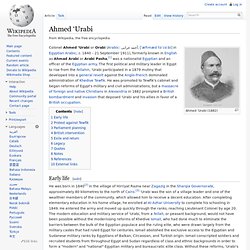
After completing elementary education in his home village, he enrolled at Al-Azhar University to complete his schooling in 1849. He entered the army and moved up quickly through the ranks, reaching Lieutenant Colonel by age 20. Alfred Milner, 1st Viscount Milner. Alfred Milner, 1st Viscount Milner KG GCB GCMG PC (23 March 1854 – 13 May 1925) was a British statesman and colonial administrator who played an influential leadership role in the formulation of foreign and domestic policy between the mid-1890s and early 1920s.
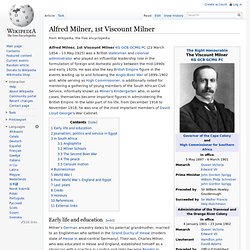
He was also the key British Empire figure in the events leading up to and following the Anglo-Boer War of 1899–1902 and, while serving as High Commissioner, is additionally noted for mentoring a gathering of young members of the South African Civil Service, informally known as Milner's Kindergarten who, in some cases, themselves became important figures in administering the British Empire. In the later part of his life, from December 1916 to November 1918, he was one of the most important members of David Lloyd George's War Cabinet. Balfour Declaration. The Balfour Declaration (dated 2 November 1917) was a letter from the United Kingdom's Foreign Secretary Arthur James Balfour to Baron Rothschild (Walter Rothschild, 2nd Baron Rothschild), a leader of the British Jewish community, for transmission to the Zionist Federation of Great Britain and Ireland.
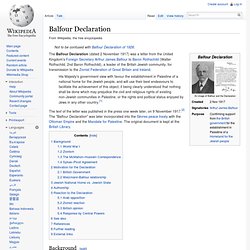
His Majesty's government view with favour the establishment in Palestine of a national home for the Jewish people, and will use their best endeavours to facilitate the achievement of this object, it being clearly understood that nothing shall be done which may prejudice the civil and religious rights of existing non-Jewish communities in Palestine, or the rights and political status enjoyed by Jews in any other country.[1] Background[edit] Black Narcissus. Black Narcissus achieved acclaim for its pioneering technical mastery, with the cinematographer Jack Cardiff, shooting in vibrant colour, winning an Academy Award for Best Cinematography and a Golden Globe Award for Best Cinematography, and Alfred Junge winning an Academy Award for Best Art Direction.
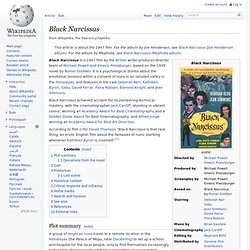
Plot summary[edit] Deviations from the novel[edit] Britain's involvement in Africa 1868-1902 pt1. Cecil Rhodes. Historian Richard A.
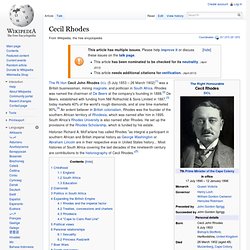
McFarlane has called Rhodes "as integral a participant in southern African and British imperial history as George Washington or Abraham Lincoln are in their respective eras in United States history... Most histories of South Africa covering the last decades of the nineteenth century are contributions to the historiography of Cecil Rhodes. "[5] Commonwealth of Nations. The Commonwealth of Nations, commonly known as the Commonwealth (also, the British Commonwealth),[1] is an intergovernmental organisation of 53 member states[2] that were mostly territories of the former British Empire.

The Commonwealth operates by intergovernmental consensus of the member states, organised through the Commonwealth Secretariat, and non-governmental organisations, organised through the Commonwealth Foundation.[3] The Commonwealth dates back to the mid 20th century with the decolonization of the British Empire through increased self-governance of its territories.
It was formally constituted by the London Declaration in 1949, which established the member states as "free and equal".[4] The symbol of this free association is Queen Elizabeth II who is the Head of the Commonwealth. Cutting the British Empire Down to Size. Decolonization: A History of Failure? Decolonization: The End of Empire? - Professor Richard J. Evans. Dominion. Dominions are autonomous polities that were nominally under British sovereignty, constituting the British Empire and British Commonwealth, beginning in the later part of the 19th century.[1][2] They have included Canada, Australia, Pakistan, India, Ceylon (Sri Lanka), New Zealand, Newfoundland, South Africa, and the Irish Free State.
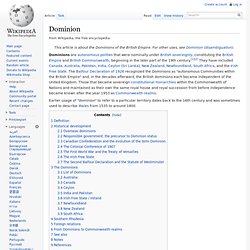
The Balfour Declaration of 1926 recognized the Dominions as "autonomous Communities within the British Empire" and, in the decades afterward, the British dominions each became independent of the United Kingdom. Those that became sovereign constitutional monarchies within the Commonwealth of Nations and maintained as their own the same royal house and royal succession from before independence became known after the year 1953 as Commonwealth realms. Earlier usage of "dominion" to refer to a particular territory dates back to the 16th century and was sometimes used to describe Wales from 1535 to around 1800. Dominion of Newfoundland. The Union Flag was adopted by the legislature as the official national flag of the Dominion of Newfoundland on 15 May 1931, before which time the Newfoundland Red Ensign, as civil ensign of Newfoundland, was used as the national flag (though not officially adopted by the legislature).[3] Political origins[edit] The Newfoundland Blue Ensign, colonial flag from 1870 to 1904 In 1854 the British government established Newfoundland's responsible government.[4] In 1855, Philip Francis Little, a native of Prince Edward Island, won a parliamentary majority over Sir Hugh Hoyles and the Conservatives.

Little formed the first administration from 1855 to 1858. Egyptian Revolution of 1952. The revolution was faced with immediate threats from Western imperial powers, particularly the United Kingdom, which had occupied Egypt since 1882, and France, both of whom were wary of rising nationalist sentiment in territories under their control throughout the Arab world, and Africa.
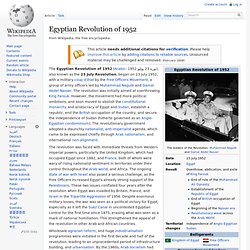
The ongoing state of war with Israel also posed a serious challenge, as the Free Officers increased Egypt's already strong support of the Palestinians. These two issues conflated four years after the revolution when Egypt was invaded by Britain, France, and Israel in the Tripartite Aggression of 1956. Fourteen Points. The U.S. had joined the Allies in fighting the Central Powers on April 6, 1917. Its entry into the war had in part been due to Germany's resumption of submarine warfare against merchant ships trading with France and Britain. However, Wilson had not entered into the war with any affinity with the long-festering almost tribal disputes between the Allies and Germany; if America was going to fight, he would try to unlink the war to nationalistic disputes or ambitions. The need for high aims was made more important, when after the fall of the Russian Regime, the Bolsheviks disclosed secret treaties made between the allies.
Government of India Act 1935. Overview[edit] The most significant aspects of the Act were: the grant of a large measure of autonomy to the provinces of British India (ending the system of dyarchy introduced by the Government of India Act 1919)provision for the establishment of a "Federation of India", to be made up of both British India and some or all of the "princely states"the introduction of direct elections, thus increasing the franchise from seven million to thirty-five million peoplea partial reorganization of the provinces: Sindh was separated from BombayBihar and Orissa was split into separate provinces of Bihar and OrissaBurma was completely separated from IndiaAden was also detached from India, and established as a separate Crown colonymembership of the provincial assemblies was altered so as to include more elected Indian representatives, who were now able to form majorities and be appointed to form governmentsthe establishment of a Federal Court.
Gunga Din (film) Gunga Din is a 1939 RKO adventure film directed by George Stevens and starring Cary Grant, Victor McLaglen and Douglas Fairbanks, Jr., loosely based on the poem of the same name by Rudyard Kipling combined with elements of his short story collection Soldiers Three. The film is about three British sergeants and Gunga Din, their native bhisti (water bearer), who fight the Thuggee, a cult of murderous Indians in colonial British India. They find Tantrapur apparently deserted and set about repairing the telegraph. History of Egypt under the British. History of Egypt under the British refers to the era from 1882 when the British succeeded in defeating the Egyptian Army at Tel El Kebir in September and took control of the country to the 1952 Egyptian revolution which made Egypt a republic and when British advisers were expelled.
British administration[edit] Throughout the 19th century, the ruling dynasty of Egypt had spent vast sums of money on infrastructural development of Egypt. In what ways did Britain maintain control over its colonies? pt1. Indian independence and British decolonisation pt1. Indian independence movement. The term Indian Independence Movement encompasses a wide range of areas like political organizations, philosophies, revolutionaries and movements which had the common aim of ending the company rule (East India Company), and then British imperial authority, in parts of South Asia.
The independence movement saw various national and regional campaigns, agitations and efforts, some nonviolent and others not so. The first organised militant movements were in Bengal, but they later took to the political stage in the form of a mainstream movement in the then newly formed Indian National Congress (INC), with prominent moderate leaders seeking only their basic right to appear for Indian Civil Service examinations, as well as more rights, economic in nature, for the people of the soil. The early part of the 20th century saw a more radical approach towards political independence proposed by leaders such as the Lal, Bal, Pal and Aurobindo Ghosh. Background (1757–1883)[edit] Vellore sepoy mutiny[edit] Journal of Contemporary History, Vol. 20, No. 3 (Jul., 1985), pp. 469-481. Khmers rouges. League of Nations. Movement for Colonial Freedom. Paris Peace Conference, 1919. Popularity of imperialism in Britain 1880-1902 pt1. Racism: A History [2007] - 1/3.
Saad Zaghloul. Sanders of the River. Script. Simon Commission. Singapore Declaration. The Drum (1938 film) The First World War and The British Empire pt1. Timeline: The Commonwealth. Wafd Party. Égypte sous les Alaouites.